
 Thatch is a natural reed and grass which, when properly cut, dried, and installed, forms a waterproof roof. Traditionally thatchers use locally available materials. If local farmers were growing wheat, then wheat reed or straw was used. Rye, barley and oat straw, and even heathers have been used. In wet lowlands, sedge has been a traditional thatch, particularly for ridging material.
Thatch is a natural reed and grass which, when properly cut, dried, and installed, forms a waterproof roof. Traditionally thatchers use locally available materials. If local farmers were growing wheat, then wheat reed or straw was used. Rye, barley and oat straw, and even heathers have been used. In wet lowlands, sedge has been a traditional thatch, particularly for ridging material.
The most durable thatching material is water reed which can last up to 60 years.
Clive Dodson Thatchers are one of very few thatschers that grow our own reed, this way we can guarantee the quality of our raw material.
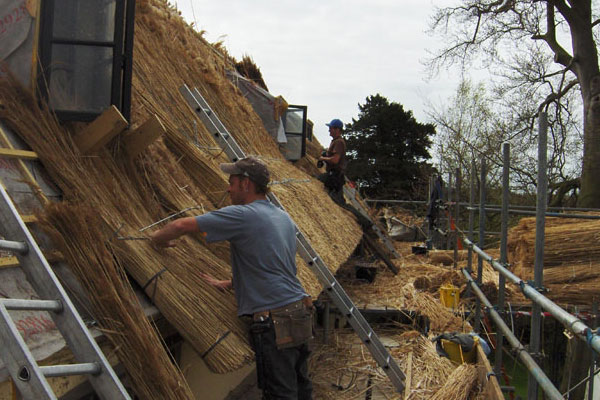 Water reed is naturally waterproof. This is no waterlogged plant, soggy and bloated with water. In fact, the inside of a natural water reed is hollow. The water is kept out by the tight overlapping of cells on the plant’s outer layers. If you bundle enough of these water shedding plants together, water simply cannot penetrate. Moisture typically does not absorb into the thatch bundles more than 1 or 2 inches.
Water reed is naturally waterproof. This is no waterlogged plant, soggy and bloated with water. In fact, the inside of a natural water reed is hollow. The water is kept out by the tight overlapping of cells on the plant’s outer layers. If you bundle enough of these water shedding plants together, water simply cannot penetrate. Moisture typically does not absorb into the thatch bundles more than 1 or 2 inches.
Thatching consists of carefully laying 5 to 6 foot bundles of reeds on top of one another so that an impenetrable shell of waterproofing covers a roof. Each thatch layer is built up to a thickness of around 12 inches and gravity carries rain, sleet, and snow down and off the roof.
 One of the great attractions of thatch is that is extremely thermally efficient – warm in winter and cool in summer. Unlike conventional roofing systems that trap heat and moisture vapour in attics, thatched roofs require no attic ventilation.
One of the great attractions of thatch is that is extremely thermally efficient – warm in winter and cool in summer. Unlike conventional roofing systems that trap heat and moisture vapour in attics, thatched roofs require no attic ventilation.
A water reed thatched roof, 12 inches thick at a pitch angle of 45 degrees meets the most modern insulation standards. The scientific term for insulating properties is “thermal conductance,” known as the U value. The U-value of a properly thatched roof is 0.35, which is equivalent to 4 inches of fibreglass insulation between the joists. Only in the last decade have building codes begun to demand this level of roof insulation. Yet, thatch has been providing such a “modern” value for hundreds of years.
An added benefit is that thatch is a much more effective sound insulation than fiberglass. An inch of thatch will stop a microphone from picking up sounds.
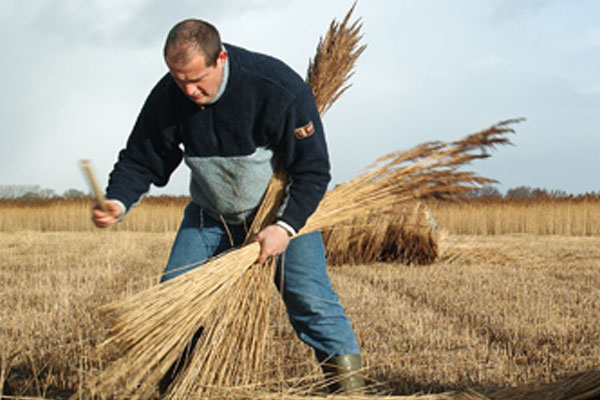 From a conservation point of view thatch is less demanding on the land as the raw materials do not require quarrying or mining. Water reed… is a natural crop that, properly maintained, promotes the surival of wildlife and improves the environment generally; perhaps even more importantly, it grows in areas which are otherwise agriculturally unviable. The alternative thatching material, straw, is a by-product of an essential food harvest. So neither product creates wastage or is a drain on the world’s natural resources.
From a conservation point of view thatch is less demanding on the land as the raw materials do not require quarrying or mining. Water reed… is a natural crop that, properly maintained, promotes the surival of wildlife and improves the environment generally; perhaps even more importantly, it grows in areas which are otherwise agriculturally unviable. The alternative thatching material, straw, is a by-product of an essential food harvest. So neither product creates wastage or is a drain on the world’s natural resources.
Also, organic thatch weathers to produce a warm, textured, charcoal patina over decades of service. For appearance, warmth, charm, and performance, nothing approaches thatch.
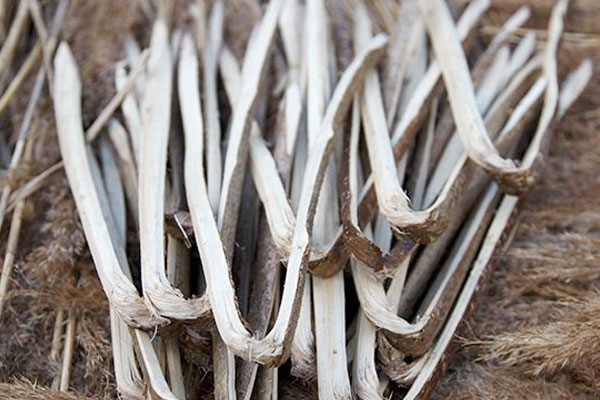 Modern thatching methods make thatch one of the strongest types of roofs, certainly one better able to handle high winds than common asphalt strip shingles.
Modern thatching methods make thatch one of the strongest types of roofs, certainly one better able to handle high winds than common asphalt strip shingles.
Before thatch is placed on a roof, long brass screws are firmly inserted deep into the wooden roof laths. Twisted onto the screw is a long, heavy duty steel wire. Bundles of reeds are then placed onto the roof. Over the bound reed bundles steel rods are placed. Then the wire which is secured to the lathing is tied through the reeds to the steel rods. The result is a natural water-repelling material firmly bound by steel rods and wires to the roof laths and joists.
You won’t see the steel rods or wires since these are buried 5 to 6 inches below the top reed layer. The result is a light yet extremely durable, steel tied roof.
It should be noted that when rethatching and conserving older buildings, we do not use steel, but the more traditional (and quite effective) wood spar system.
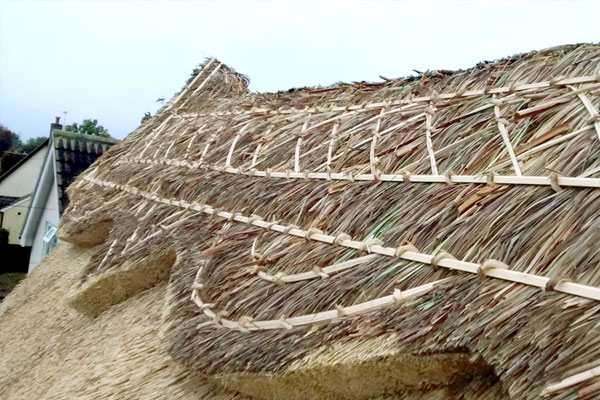 The roof ridge is best made of a more pliable and better bonding material than water reed. Wheat straw is preferred for this purpose and it is held in place with wooden spars. It is important that winter wheat be used since it is stronger and more durable than spring wheat.
The roof ridge is best made of a more pliable and better bonding material than water reed. Wheat straw is preferred for this purpose and it is held in place with wooden spars. It is important that winter wheat be used since it is stronger and more durable than spring wheat.
There are two basic forms of ridge: flush and block. A flush ridge is just that – it is flush with the rest of the roof line and does not stand out from it. A block ridge, on the other hand, is built up and then cut to form a block raised very visibly over the roof ridge.
Technically, both ridge styles are equal. Each does the job of sealing the ridge line quite effectively. The choice of which to use is usually one of aesthetics. Flush ridges are more understated. Block ridges stand out more and can be cut in quite elaborate styles. Thatchers each have their own distinctive style of ridge patterns, and experts can tell who thatched a building with a glance at the ridge line.
Patterns produced by the woven spars are there for the entirely practical purpose of holding down the straw on the ridge. Happily, this is an example where beautiful form flows naturally from function.
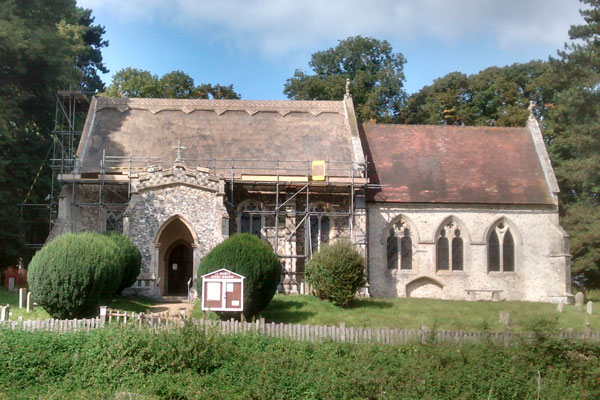 Clive Dodson Thatchers has placed thatched roofs on everything from small residential cottages to large commercial establishments
Clive Dodson Thatchers has placed thatched roofs on everything from small residential cottages to large commercial establishments
There is a practical consideration – the roof should have a slope no less than 45 degrees (12 inches in 12 inches) to aid in the shedding of water. 50 degrees is better. In high snow areas, this pitch should be considered minimum.
Certain eave and dormer window designs work better with thatch than others. Thatch weighs only 7 pounds per square foot, so no special roof reinforcing is needed.
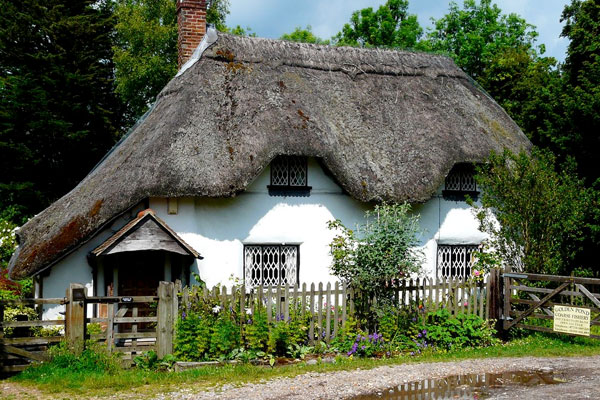 When thatched properly by professionals, the major portion of such a roof (the water reed) should last 40 to 50 years. In other words, as long as any other roof.
When thatched properly by professionals, the major portion of such a roof (the water reed) should last 40 to 50 years. In other words, as long as any other roof.
However, the roof ridge will have to be replaced roughly every 8 – 10 years. Such ridge line replacement is, luckily, a fairly rapid and reasonably inexpensive procedure.
 Distinction carries a price, but not an unacceptable one. A typical thatched roof costs more than its cement tiled or slated roof counterparts. But, since the carpentry and wood work needed to support a thatched roof is less expensive, overall costs are comparable. Further, there are no gutters, downpipes, soakaways, soffit boards, or the need to paint and maintain these items.
Distinction carries a price, but not an unacceptable one. A typical thatched roof costs more than its cement tiled or slated roof counterparts. But, since the carpentry and wood work needed to support a thatched roof is less expensive, overall costs are comparable. Further, there are no gutters, downpipes, soakaways, soffit boards, or the need to paint and maintain these items.
In this picture you’ll note the detailing over a window. The cut of the thatch and the direction in which it is laid helps shed water to the sides and not onto the window below.
We will always supply you with a completion quote before commencing any work.
 There is no problem getting insurance on your thatched building, most companies will insure a thatched property and there are also specialist insurance firms.
There is no problem getting insurance on your thatched building, most companies will insure a thatched property and there are also specialist insurance firms.
As Master Thatchers we are certified by some of the insurance industries blue chip companies and are regulated to provide the safest fireproofing insulation available. The cost to you is generally the same as that required for a similar building with a conventional roof.
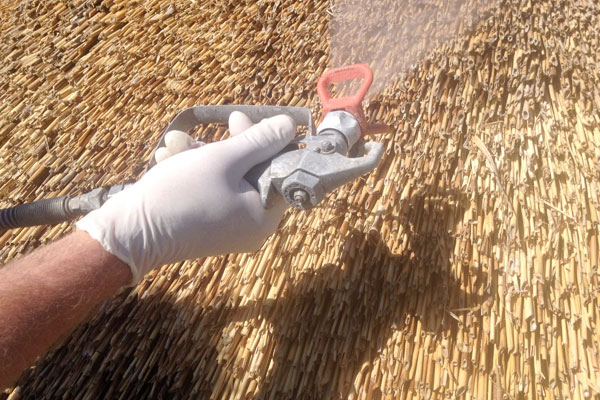 Thatch is a natural product and it will burn, however there are a great many solutions to this problem on the market from fireproof foil to a specially created insulation that helps prevent the chances of a fire spreading through a thatched roof.
Thatch is a natural product and it will burn, however there are a great many solutions to this problem on the market from fireproof foil to a specially created insulation that helps prevent the chances of a fire spreading through a thatched roof.
For more information about all the options available and the safety standards we adhere to visit our fireproofing page and if you have any further questions please don’t hesitate to get in touch with us.
 Rats and mice are attracted to holes. A properly thatched roof won’t have any. Rodents won’t go into properly set water reed because there’s nothing in there to interest them. Again, it should be pointed out that thin asphalt shingles are much easier for rodents to get into than 12 inches of strong water reed. If you don’t have problems with a standard roof, you won’t have them with a thatched roof.
Rats and mice are attracted to holes. A properly thatched roof won’t have any. Rodents won’t go into properly set water reed because there’s nothing in there to interest them. Again, it should be pointed out that thin asphalt shingles are much easier for rodents to get into than 12 inches of strong water reed. If you don’t have problems with a standard roof, you won’t have them with a thatched roof.
Birds are a more troublesome problem. The water reed is too well bound and heavy for the birds to pull it out. But, the wheat straw in the ridge line is quite attractive to nest building birds. There are three ways to keep this damage to a minimum. First and foremost, the ridge pattern work must be strong and effective.
If damage appears, it must be fixed promptly. Damage or no, you’ll have to plan on replacing the roof ridge every 8 to 10 years. Finally, if birds are just a tremendous nuisance in your area, chicken mesh laid over the roof will help protect your thatch further and when done properly, the wire will not affect the look of your thatched roof.
Rats and mice are attracted to holes. A properly thatched roof won’t have any. Rodents won’t go into properly set water reed because there’s nothing in there to interest them. Again, it should be pointed out that thin asphalt shingles are much easier for rodents to get into than 12 inches of strong water reed. If you don’t have problems with a standard roof, you won’t have them with a thatched roof.
Birds are a more troublesome problem. The water reed is too well bound and heavy for the birds to pull it out. But, the wheat straw in the ridge line is quite attractive to nest building birds. There are three ways to keep this damage to a minimum. First and foremost, the ridge pattern work must be strong and effective. That’s no problem if you hire the professionals at The Thatch Company. Second, if damage appears, it must be fixed promptly. Damage or no, you’ll have to plan on replacing the roof ridge every 8 to 10 years. Finally, if birds are just a tremendous nuisance in your area, chicken mesh wiring can be laid over the roof so that no critters can get at it. When done properly, such wiring does not overly affect the look of your thatched roof.